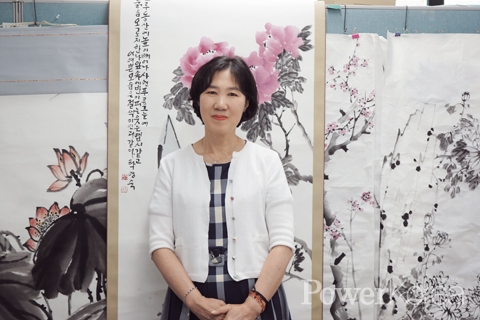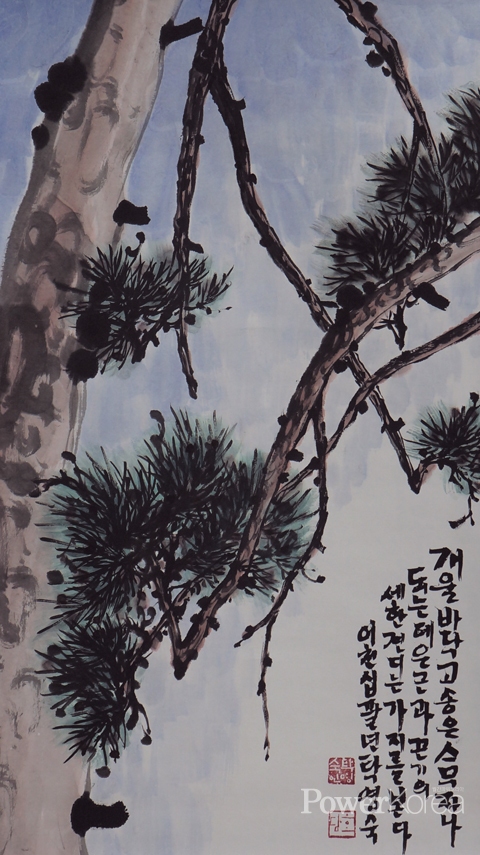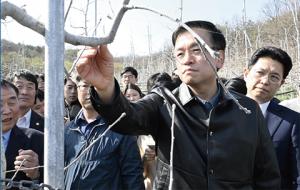 |
||
| ▲ Literary Painting Artist Youngsook Tak | ||
I grind an ink stick again drenched in the yesterday’s ink smell still lingering in my studio. I didn’t realize I’ve come to this far but here I am. I believe in this maxim: “100 strokes make an example, 1,000 strokes make a well written but 10,000 strokes make a master”. So I put my sweat and tears as well as thoughts and emotions in every single word I write. I hope people find some energy of life with which they can sail through this harsh world from my works.” - Artist’s note –
Learning under instruction of Yoosun Choi
Youngsook Tak, aka Hodam, was born in Gwangwon Province. She liked drawing very much that she often sit under a cherry tree to draw something of her own. Seeing her works by chance, the principal of her school advised her to be an artist. But things didn’t turn out as they wished. She majored in English literature instead of art at university and taught children at an academy after graduation. One day, however, she came to know by chance that there was a painting class at a cultural center near her home and she knocked the door which might bring her back her childhood dream.
As her skill grew month by month, she decided to deepen it at the studio of her teacher Yoosun Choi, aka Choijeong. Unlike others who start with calligraphy, she started straight with literary painting thanks to her kind teacher who built up the basics step by step for her with utmost detail.
“One must express 12 colors with just ink and water and one must complete a literary painting with lines and blank to be a master, said my teacher. I’ve never forgotten this advice and it always has been a trustworthy guide for me to be who I am today.”
It is very important how to grind an ink stick when drawing literary painting. Her teacher always advised Tak with an emphasis on slowness in calm mind when grinding an ink stick because one’s state of mind greatly affects the brush works and the results.
Talents shined in competitions
Historically, literary painting was an exclusive property of nobles and scholars. They loved to draw plum blossom, orchid, chrysanthemum and bamboo which are called ‘Four Gentlemen’ or ‘Four Noble Ones’. Easier said than done! Every single stroke of brush takes a considerable amount of physical and mental energy if one is to draw a master piece or a well painted at least. Orchid seems to be the easiest among the four but many literary painters voice together it actually is the hardest.
“There are many things to learn about how to use ink. One must make second nature of spread, overlap and gradation. My teacher advised to look at the amount of water on the ink plate rather than the objects I was drawing. It means adjusting the amount of water is crucial to draw the desired lines. It might be a little difference but the result shows a significant difference.”
Tak has won a number of prizes at various competitions: a special prize at the Korea Literary Painting Grand Exhibition, the top prize at a competition organized by the Korean Fine Arts Association, and another special prize at the Gyeonggi Art Contest Exhibition-Painting in the Literary Artists Style.
“It was inspiring to hear a story of a fellow artist who drew a landscape in harsh winter weather outside to give a realistic feel to the work. That was and is exactly what I endeavor to achieve and I think winning a number prizes might be the results of this attitude about my works.”
Fostering young talents
Being an artist aside, Tak is yet again deepening her skills and knowledge about literary painting at Kyung Hee University Graduate School of Education at the moment. Alongside study, she is willing to make herself busy passing down her skills to young ones and adults alike by splitting a time.
“I start with the very basic skills like using ink and water, knowing the characteristics of Korean rice paper, and how to draw landscape, before moving onto Four Gentlemen. Those who still have difficulty drawing Four Gentlemen, I apply lotus, magnolia and pine tree. To add fun, l also apply folding fans and cotton cloths instead of Korean rice paper.”
Painting is patience
“Painting is patience” says Tak. In other words, detail is more important than speed if an artist want to make a work without regret; when someone asked her to draw plum flowers, the first thing that popped up in her head was to draw it as if the fragrance really spread out; so it would be ok that no matter how much time it takes if one is to give a perfection to a work.
As for the business side, Tak has this idea of applying calligraphy and literary painting onto various household items such as cushions, bags, partitions, etc. so that the art should be for everybody to enjoy rather than an exclusive property of galleries. Cheers for it!
 |
||
안정희 기자 honesty5835@naver.com







